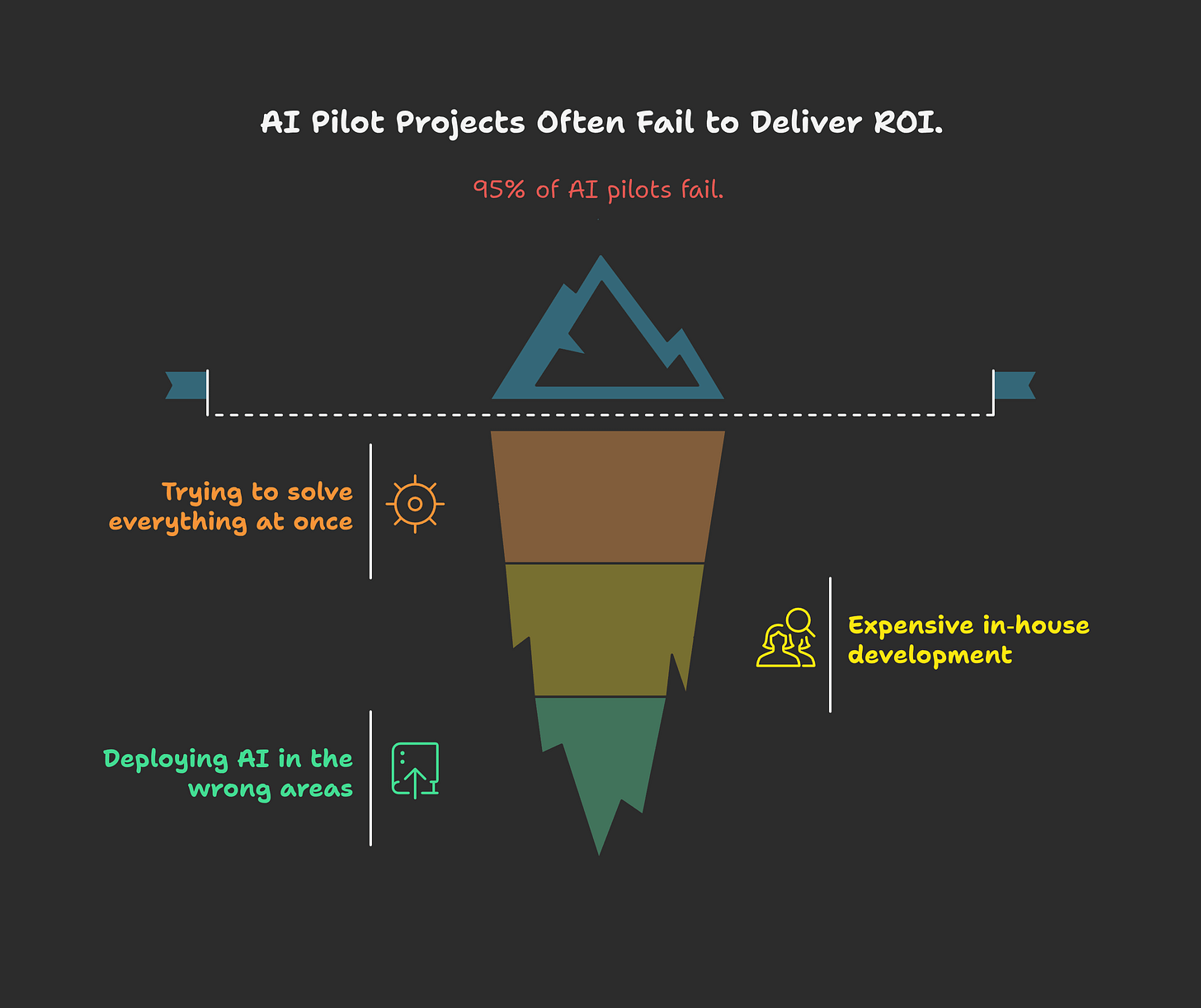The AI Disaster Report: 9‑out‑of‑10 Pilots Deliver Zero ROI
I just finished the latest MIT study on AI adoption, and the findings are mind-blowing.
Out of the roughly $35‑$40 billion poured into AI pilots, 95% are delivering little or no measurable profit.
The “GenAI Divide: State of AI in Business 2025” report (MIT) draws on 150 executive interviews, a survey of 350 employees, and an analysis of 300 public AI deployments. This research shows that on 5% sees value in AI.
You can read press coverage of the report here: Fortune – 95% of generative‑AI pilots failing.
The full study is available for download here: Download the MIT report.
Most common causes of failure
Trying to solve everything at once – spreading effort thin weakens their impact.
In‑house development is super expensive – custom models cost time, talent, and money.
Deploying AI in the wrong areas – low-value, high-visibility tasks rarely yield a return on investment.
Key to successful projects
Successful startups have turned zero revenue into $20 M in a year by focusing on a single problem, executing it well, and partnering with companies that use their tools.
While more than half of AI budgets go to sales‑and‑marketing tech, the biggest ROI still lives in back‑office automation—cutting outsourcing, agency fees, and manual hand‑offs.
Data shows that purchased solutions outperform in-house developed ones on reliability and value speed to value.
Most companies try to develop their own tools, but the data shows that purchased solutions delivered more reliable results.
The other winning tactic is to empower line managers (not just central AI labs) to drive adoption, and choose tools that integrate deeply and adapt over time.
Checklist for your next AI project
Pick ONE narrow problem – e.g., “reduce manual bug‑triage time by 30%.”
Choose an existing tool – find a solution that already handles part of the job.
Define a KPI – time saved, tickets closed, review turnaround, etc.
Run a short pilot (2‑4 weeks) – collect data, iterate, then decide to scale or stop.
Document the outcome – share what worked and what didn’t with the rest of the engineering org.
How to talk about it with stakeholders
Be transparent: “We’re testing X to see if we can shave Y minutes off the workflow.”
Show the numbers: Even a modest 10% improvement can be a win if the baseline is high.
Plan an exit: If the pilot misses its KPI, we’ll pivot, so no bias towards sunk costs.
Quick email template you can use
Subject: Small AI Test – Faster Code Reviews in Two Weeks
Hey team,
I’m launching a quick experiment to see if an AI‑powered code‑review bot can trim the time we spend on PR feedback.
What we’ll use: GitHub’s built‑in Copilot Chat (no extra infrastructure).
Goal: Reduce average review turnaround from ~48 hours to ≤ 30 hours for the next two weeks.
How we’ll measure it: Track the time between PR open and first reviewer comment, plus a short survey on usefulness.
Roll‑out plan: Enable the bot on the frontend‑service repo only; the rest of the codebase stays unchanged.
I’ll post a brief status update every Friday in #ai-pilot‑updates. Your thoughts are welcome—drop me a note anytime.
Thanks for helping us test this out!
— [Your Name]
Bottom line
Stay financially disciplined, target a single high‑impact problem, and lean on proven tools to turn AI from hype into a genuine productivity boost.
Keep experimenting, measuring, and sharing both what works and what doesn’t. That way, you’ll become the go‑to leader known for delivering tangible AI results.
—Gábor
1:1 Mentorship
Turn the ideas from this newsletter into real results with a focused, nine‑lesson program:
Three modules – each delivered as three × 1‑hour live lessons
Building High‑Performing Teams – team formation, workflow optimisation, continuous improvement.
Effective Tech Leadership – mindset, delegation, feedback & coaching.
Stakeholder Collaboration – mapping expectations, structured updates, negotiation.
What you get: after every lesson you receive 2–3 ready‑to‑use tools (radar charts, time‑blocking templates, negotiation checklists, retro‑action trackers, etc.) that you can apply immediately.
How it works
Free 30‑minute discovery call – we discuss your challenges and confirm fit.
Live online lessons – each session is conducted in real time, so you’ll be fully present for the interaction.
Tool delivery – resources are sent right after each session.
Visit my website at gabortill.com/mentorship for more details and a free discovery call.



This explains why so many AI demos look cool but never stick in production.